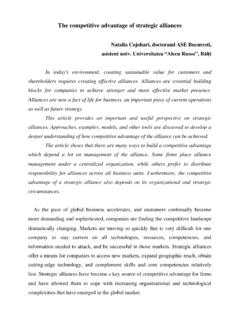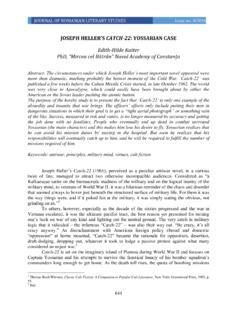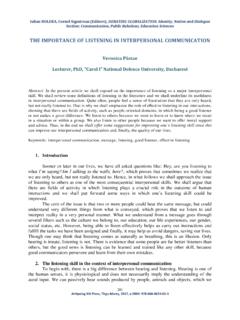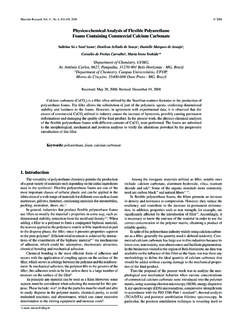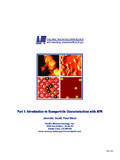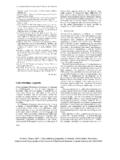Transcription of A LINGUISTIC ANALYSIS OF JOKES - upm.ro
1 DISCOURSE AS A FORM OF MULTICULTURALISM IN LITERATURE AND COMMUNICATION SECTION: LANGUAGE AND DISCOURSE ARHIPELAG XXI PRESS, T RGU MURE , 2015, ISBN: 978-606-8624-21-1 159 A LINGUISTIC ANALYSIS OF JOKES Anca Tomoioag Assist. Prof., PhD, Emanuel University of Oradea Abstract: The present study focuses on JOKES from a LINGUISTIC perspective, trying to describe the dual specific structure a joke is built on in order to define the specificity of JOKES , in general. Being considered as forms of oral literature, JOKES detain a large diversity of forms, from riddle JOKES to puns and ethnic JOKES , but the structural dualism remains persistent.
2 Subsequently, the study refers to the isotopies a joke might be constructed on, to the opposed scripts, to the surprising switch from an interpretation of a joke first meaning towards a secondary unexpected interpretation, to the mechanisms that produce the funniness of a joke. Keywords: joke, punch line, incongruity, verbal humour, contrastive scripts. Humour has been chosen as object of study by many researchers, often becoming the centre of their sociological, psychological, philosophical and literary scholarly interests. The examples of such study works are numerous.
3 In this respect, Salvatore Attardo s chapter dedicated to a chronological Survey of the literature written about humour is more than useful. Starting with Plato and Aristotle and ending with Freud and Bergson, Attardo s both historical and analytical enterprise underlines the diachronic depth of the problematic. Nevertheless, there are less LINGUISTIC studies on humour, even if many scholars have tried to compensate this lack in the late years. Most of the researchers who focused on humorous texts and language tried to create a paradigm of analysing and defining a joke (as long as JOKES are to be considered the humorous typical production of the language).
4 The paradigm we refer to is generally coined by using the term theory. Raskin (1985), and later on, Attardo together with Raskin (1991) tried to configure what was to become the most known theories in the domain: SSTH (The Semantic Script Based Theory of Humor ) and GTVH (General Theory of Verbal Humour). Still, these models of approaching verbal humour are being continuously reshaped and sometimes put DISCOURSE AS A FORM OF MULTICULTURALISM IN LITERATURE AND COMMUNICATION SECTION: LANGUAGE AND DISCOURSE ARHIPELAG XXI PRESS, T RGU MURE , 2015, ISBN: 978-606-8624-21-1 160 under question, as in the case of Graeme Ritchie s The LINGUISTIC ANALYSIS of JOKES .
5 (2004. For further study see pages 69-88 of the mentioned study) and others. When dealing with LINGUISTIC humour, especially JOKES , scholars tried to engage themselves into quest for answers regarding different aspects form outside and inside the phenomenon of verbal humour, such as: - Adequate definition of a joke; - The mechanisms of a joke; - The qualities that make a good joke; - The relation between locator and allocator and the jokehood conventions; - The prior experiences of both hearer and speaker and their historical, national, social, psychological individualities.
6 The present study intends to describe the dualism of a joke, one of the LINGUISTIC mechanisms scholars have been interested regarding verbal humour, specifically JOKES , so that we may establish the approximate frames for such a notional sphere the term joke has got. The scientific enterprises made in the direction of these marginal pieces of literature have been confronted with what Raskin called the volatility of , the humour phenomenon, with its Fata Morgana-like contours, implements a hardly defining effort with reference to joke.
7 Before dealing with the problematic this study is assigned for, we consider appropriate to describe in a nutshell the three well known LINGUISTIC theories of humour as theoretical basis for our research. Many researchers described these three theories, but we would prefer to mention Rodica Zafiu s delimitations. The theories in discussion, though interdependent, are confined to two categories, according to which human LINGUISTIC register they address to. Theories of Incongruity are oriented towards the cognitive mechanisms; meanwhile the Hostility Theories and the Release Theories deal with the psychological causes and effects of The two types of theories focus on the causes that determine a person to verbalise a joke and the effects it produces within the person s psychological forum.
8 Firstly, the Hostility Theories refer to the aggressive aspect of humour. Such JOKES imply a condescend humour, patronizing the other for a weakness, for low social class, for upper social class, for ignorance, 1 Victor Raskin, Semantic Mechanisms of Humour, D. Reidel Publishing Company, Dordrecht, Holland, 1985, p. 111 2 Rodica Zafiu, Evaluarea umorului verbal (p. 497-505), in G. Pan Dindelegan (ed.): Limba rom n . Stadiul actual al cercet rii, Bucharest, Editura Universit ii din Bucure ti, p. 498 DISCOURSE AS A FORM OF MULTICULTURALISM IN LITERATURE AND COMMUNICATION SECTION: LANGUAGE AND DISCOURSE ARHIPELAG XXI PRESS, T RGU MURE , 2015, ISBN: 978-606-8624-21-1 161 for stereotypical behaviour and so on.
9 The comic literature aimed in a certain historical period to penalise social/ human defects through humour and laughter. Bergson considered humour a social corrective 3, but this perspective increases and denounce the JOKES speaker s sense of superiority, and, consequently, this person s aggressiveness and lack of empathy towards the other. This aggressive side of JOKES has been largely debated, mostly because of its specific controversies. A following section of the present study will describe more clearly the consequences of such humour. Secondly, the Release Theories deal with the joke s cathartic power.
10 Humour and laughing, sometimes seen as therapies, release cognitive and emotional tensions, abolishing inflexible laws exactly the way playing does through its gratuitousness. That is why word games are such modalities of suppressing even the LINGUISTIC rules, becoming redemptory. Certain JOKES play with words and distort them in such a way so that the catharsis could be produced. Theories of Incongruity focus on the dissonance every joke seems to build on in order to produce funniness. Salvatore Attardo names it a mismatch between two ideas 4, focusing on the contrast between the hearer s expectations and the surprising resolution given by the speaker.

